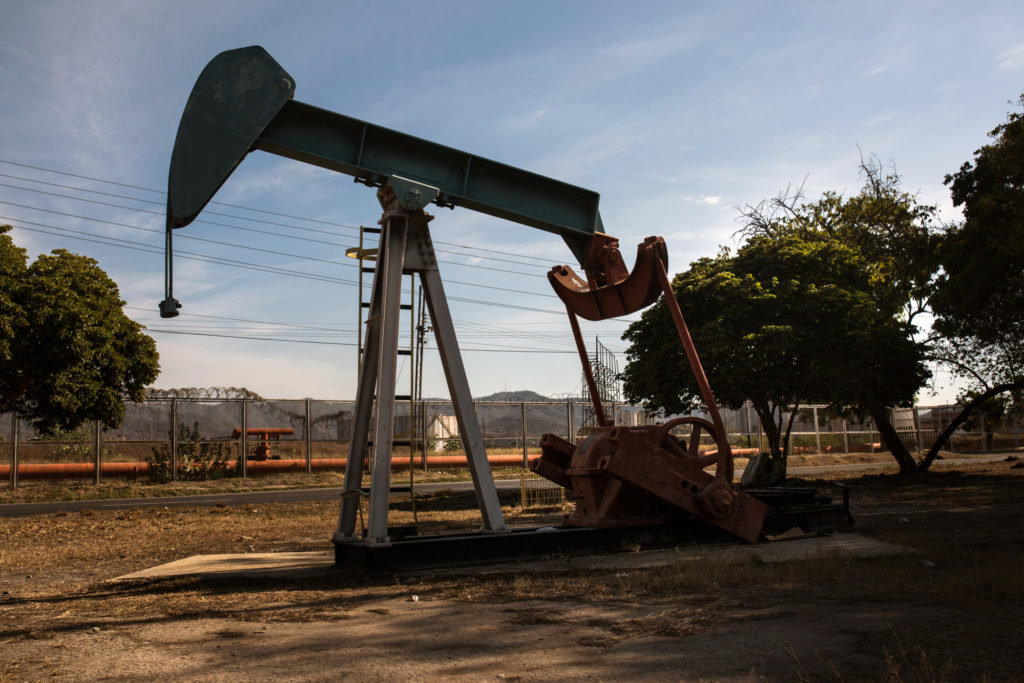
OPEC is heeding consumers’ calls to pump more crude, but that’s only making the oil market more nervous.
The fleeting reassurance that came from Saudi Arabia’s pledge last week to lead a substantial production increase was swept away on Tuesday as tougher U.S. sanctions on Iran shifted focus back to the world’s dwindling buffer of emergency crude supply.
“The reduction in spare capacity by OPEC” leaves “pricing risk more exposed to the upside,” said Brian Singer, managing director at Goldman Sachs Group Inc.
Idle oil fields that the Organization of Petroleum Exporting Countries and its allies — predominantly Saudi Arabia — can deploy in emergencies have a total capacity of about 3.4 million barrels a day, according to the International Energy Agency.
Those reserves will shrink as the group implements the 1 million-barrel-a-day supply boost pledged in Vienna last week. Saudi Arabia’s plan to increase output to a record 10.8 million barrels a day next month would use up about 40 percent of its idle capacity, leaving the world with a buffer equivalent to just 2.6 percent of global supply.
That would limit OPEC’s ability to react to further disruptions — and there are plenty coming. Venezuela’s output is predicted to slump further as its economic crisis worsens. Earlier this month, Libya unexpectedly lost 400,000 barrels a day of production as one militia attacked two key oil terminals, prompting another armed group to seize control of a swathe of the country’s industry.
“It basically leaves us with no spare capacity, at a time when Iran isn’t the only issue,” Amrita Sen, chief oil analyst at consultant Energy Aspects Ltd., said in a Bloomberg television interview. “Venezuelan production’s falling, Angola, Libya, Nigeria –there are lots and lots of issues everywhere in the world.”
Washington’s push for U.S. allies to completely stop buying Iranian crude by November could take another 1.5 million barrels a day from the market, according to consultant Energy Aspects Ltd.
OPEC’s dilemma was evident in price gyrations on crude markets on Tuesday. U.S. futures fell on the news that Saudi Arabia was planning a significant output boost, then surged above $70 a barrel for the first time in a month after the U.S. State Department revealed the full extent of the pressure it intends to apply to Iran’s oil industry.
Risk Factors
Venezuela is the most enduring supply risk. Its production has already plunged by about 40 percent since 2015 due to a grueling recession, civil unrest and an exodus of workers from the country’s state-run oil firm, Petroleos de Venezuela SA. The supply increase agreed by OPEC and its allies last week was primarily intended to offset these losses, but the gap they’re filling will grow again when U.S. sanctions on Iran take effect in November.
Earlier this month, the International Energy Agency said that combined production from Venezuela and Iran could plunge a further 30 percent — or around 1.5 million barrels a day — by the end of next year. That was before the U.S. announced restrictions on Iranian exports that were tighter than most analysts were expecting.
Even if OPEC and Russia compensate for that additional 1.5 million barrel-a-day loss, the market will still be “finely balanced” in 2019, the IEA said. By the end of next year, the buffer of spare capacity could diminish to the lowest in three years, the agency predicts.
That poses a significant risk to the security of global energy markets in the event of sudden and unexpected increases in demand or supply, said Goldman’s Singer. Banks on Wall Street and elsewhere said they continue to see prices climbing because of the dwindling cushion.
Rising Prices
Bank of America Corp. forecast that Brent, the global benchmark, will advance to $90 a barrel in the second quarter of next year, while UBS Group AG predicted $80 to $85 in the second half of the year. Both banks cited limited spare production capacity as the reason for the increase in price forecasts.
Brent futures traded at $76.67 a barrel in London at 9:19 a.m. local time on Tuesday.
The IEA noted that higher prices have already “raised doubts about the strength of demand growth.” In June, the agency reduced its estimate for the expected increase in global oil consumption this year by 100,000 barrels a day to 1.4 million barrels a day. Still, next year it expects the same level of growth, which is above long-term trends.
“When you do the barrel-math and you look at the supply risk out there, clearly the situation right now on the market is still very constructive for oil prices,” Harry Tchilinguirian, head of commodity market strategy at BNP Paribas SA, said in a Bloomberg television interview.
Recommended for you
